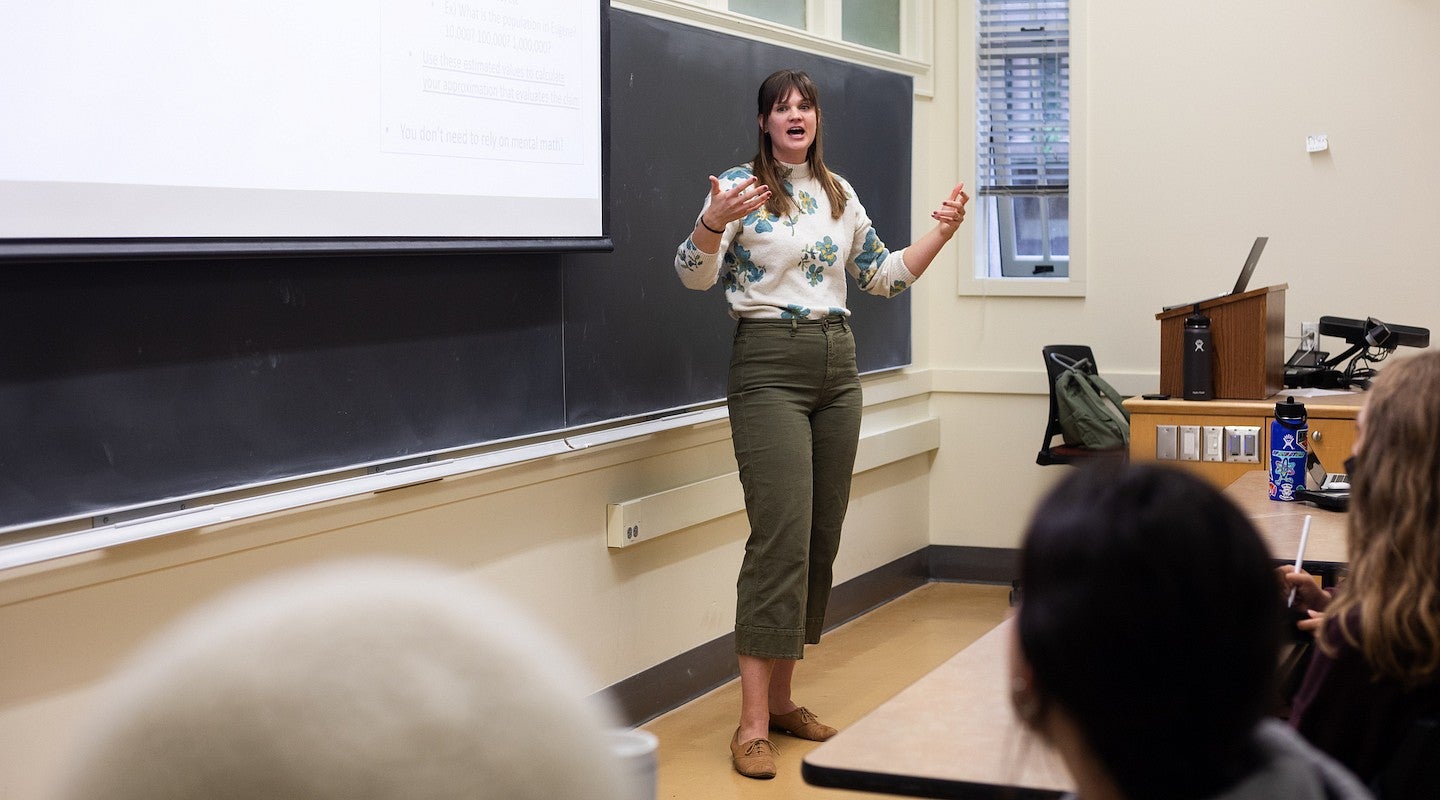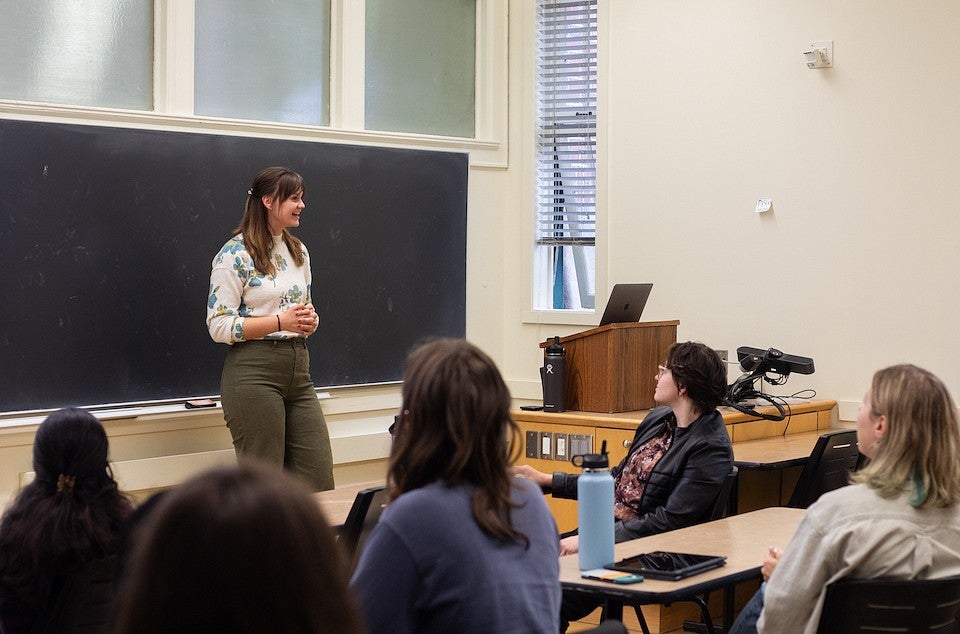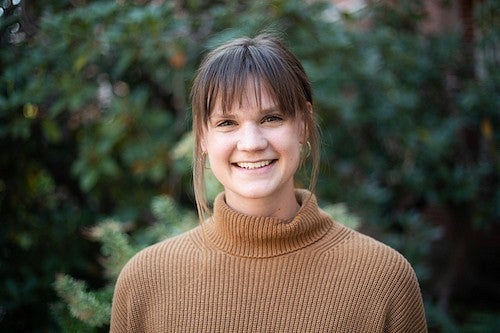
From spark to torchbearer

Funniest moment with your cats: My cat, Ginny, stole one of the slinkies I bought for my “Science of Music” class. When she doesn’t feel like she’s getting enough attention, she’ll bring her slinky over and “meow” at me until I throw it for her.
Favorite Taylor Swift album: Taylor's “1989” album came out when I was in undergrad, and I played it on repeat through so many studying sessions.
Midnight food craving: Popcorn!
Childhood TV Show: My siblings and I loved “The Land Before Time.” We thought we were dinosaur experts because of how often we watched those movies.
Rebecca Altman remembers the time in her high school chemistry class when students huddled around the teacher as he dropped a gummy bear into a test tube of bubbling potassium chlorate. It burst into flames and squealed as smoke and a rainbow of colors shot into the air.
Altman leaned in, inspired by the experiment. “What I was learning in this chemistry class was answering all of my questions that I have ever had as to why things happen,” she recalls.
This moment started her pathway into chemistry as a career where she wants to spark the same excitement in her students at the Clark Honors College. She started teaching this fall as one of 11 new core faculty members, with the goal to make science cool, easy to understand and relevant to everyone.
“I’m not necessarily here to talk about science. I’m here to talk about science with you,” she says. “So, whatever that means to you, whatever you need to understand that science, that’s what I’m here for.”
She designed her courses – “The Art of Data Manipulation” and “Beneath the Surface Science” – to reimagine the way her students engage with science. Her aim is to make the subject tangible in their daily lives.
Her classes follow her long-valued approach of “learning by doing.” In another class, “The Science of Song,” Altman used Slinkies to visualize sound waves. When learning about how culture, music, and science overlap, she guided students in building their own instruments.
“It’s never been about the topic that I’m teaching,” she says. “It’s always been about the people I’m teaching.”
Finding her spark
Altman grew up in the suburbs of Sacramento, the third of four children. Her family typically went camping for vacation, visiting national parks across the Pacific Northwest. “Those are some of my favorite memories, exploring the campground with my older brother or trying to catch chipmunks with my younger brother. Just something, outside, tangible,” she says.
One time, Altman and her sister accidentally mixed up the salt with sugar while baking cookies. The final product was a not-so-tasty batch of chocolate chip cookies, which they tried to make their brothers eat anyway.
“It comically taught me at a young age that just because two chemicals might look the same, it does not mean they should be used the same,” she says.
As a sophomore in high school, Altman’s chemistry teacher, Jeffery Comer, made learning fun and engaging for her. His eccentric personality stood out in the classroom. Once, “he just started singing a song about zombies,” Altman recalls with a laugh. “From day one, he really just tried to pull you in, and he kept that throughout.”

For Altman, Comer and chemistry made it easier to explore the world from a new perspective. “You have that thing that you learn about for the first time and there’s that spark in you, and you’re like: ‘I love this and I’m good at it,’” Altman says.
After high school, Altman went to the California Polytechnic State University. As she was finishing her freshman year, Altman received a grant to do summer research with Dr. Alan Kiste, a professor in the chemistry department. She explored how the science was taught and looked at how students learn the meanings of chemistry symbols.
“Thinking about chemistry education early on in my career definitely set me up for my long-term career goals of teaching science, and I loved the experience of doing research with a mentor and my peers,” she says.
She graduated with a chemistry degree with a focus on physical chemistry. That’s when she headed to the University of Oregon for graduate school.
She joined the Richmond Lab run by Geraldine Richmond. Altman collaborated with other lab members to use lasers to study the molecular behavior of water and how it interacts with other chemical compounds, particularly oil.
With an interest in surface science, a field which studies the interface of two substances, Altman felt driven by the work and the people in the lab.
“I felt like the people there were the people I wanted to be around,” she says now. “Research will always be research; science will always be science. I can learn anything if I put my mind to it, but I can’t change the people who I work with.”
Richmond also served as an inspiration for Altman. Her background – a presidential chair in science, a decorated professor of chemistry, and her current role as the Under Secretary for Science and Innovation at the U.S. Department of Energy – showed Altman all the possibilities for women in science.
Throughout her career, Richmond has worked to empower disenfranchised groups in STEM fields at UO and beyond. “If I had a different (principal investigator) who wasn’t as aware of the equity issues in STEM, who didn’t make such a point in their own career to acknowledge that and to fight for equity in science, I think my experience could have been very different,” Altman says.
Becoming the next leader

As part of the lab, Altman published a paper about how water and oil interact which identified an entirely new class of water vibrations at the surface of oil and proposed a new way for scientists to interpret data.
Despite the pride she felt for her work and the praise by some in the scientific community, other reviews came back brutally negative. Altman relied on Richmond’s experiences for support. Richmond would tell her students to step away from their projects and process the depth of their emotions. What Altman realized was the commitment and faith it takes to advocate for herself.
“Those are the moments that I am really proud of. Because I fought for something that I believed in, and I became a stronger person in the midst of the oppression that I felt in it,” she says.
Another benefit of being in the lab was meeting her future husband, Andrew Carpenter, who witnessed Altman’s resilience first-hand. "To watch her move through that process, and how it built the confidence in her was very inspiring to me,” he says.
Their romantic relationship kicked off with a chaotic start that included tacos and margaritas, a snapped bike chain, and a cougar sighting.
“It takes a rare person to handle everything that went wrong during that first date so lightheartedly and still make it fun, which he did flawlessly. I knew he was a keeper!” she says.
Carpenter continues to be inspired by Altman’s passion for teaching. “She’s always had a heart for advocating for student success, and that’s been really fun to watch, first as a friend and lab mate, and then as a partner,” he says.
Their world at home is relaxed. Listening to music, raising two cats, Ginny and Whiskies, going to concerts with her close friends, and spending time in nature helps Altman refocus on the values and connections that matter the most to her.

“There were definitely challenging moments, but at the end of the day the people who I knew— the people who supported me—helped me push through, helped me fight back that imposter syndrome,” she says.
As Altman reflects on her journey, she is grateful for the advocacy work led by role models around her and the community she has built. "I'm thankful for people like (Richmond) who have fought and who didn’t give up, so that my experience could be better and so that I could fight so that the person in the next generation could have an even better experience,” she says.
